#Draping Methods in Fashion Designing
Explore tagged Tumblr posts
Text
Word List: Fashion History
to try to include in your poem/story (pt. 2/3)
Exomis - a short, asymmetrical wrap garment pinned at the left shoulder, worn by men in Ancient Greece
Eye of Horus - or Wedjat eye, is an ancient Egyptian symbol that represents the eye of the falcon-headed god Horus and symbolizes healing and regeneration and was often worn for protection
Faience - a man-made ceramic material that was often used in ancient Egypt to make jewelry and devotional objects; it is usually a blue color
Falling Band - a flat and broad white collar often with lace on the edges, worn by men and women in the 17th century
Fibula - served as a pin to both hold garments together and to show status of those with prestige or power within society; was popular in Greek culture
Fichu - a triangular shawl, usually worn by women, draped over the shoulders and crossed or fastened in the front
Fontange - a linen cap with layers of lace and ribbon, worn flat and pinned to the back of the head
French Hood - a rounded headdress for women that was popular in the 16th century (from 1540)
Frock Coat - a collared man’s coat worn through the eighteenth to the twentieth century; rose to prominence mainly in the nineteenth century, especially Victorian England; characterized as a knee-length overcoat, buttoned down to the waist, that drapes over the lower half of the body like a skirt
Frogging - ornamental braid or cording that can function as a garment closure, or be solely decorative
Gabled Hood - a woman’s headdress that is wired to create a point at the top of the head and has fabric that drapes from the back of the head
Gigot Sleeve - a sleeve that was full at the shoulder and became tightly fitted to the wrist; also called leg-of-mutton sleeve
Guipure Lace - a type of continuous bobbin lace made without a mesh ground; its motifs are connected by bridges or plaits
Himation - a rectangular cloak wrapped around the body and thrown over the left shoulder worn by the ancient Greeks
Huipilli/Huipil - a woven rectangular shirt worn by women in Central America beginning in ancient times
Jerkin - a close-fitting men’s jacket, often worn for warmth, sometimes without sleeves; worn over a doublet in the 16th and 17th centuries
Justaucorps - a long-sleeved, knee-length coat worn by men after 1666 and throughout the 18th century
Kaftan - (also caftan) is an ancient garment, which originated in ancient Persia but then spread across Central and Western Asia; a kind of robe or tunic that was worn by both men and women
Katazome (stencil printing) - a traditional Japanese method for printing designs onto fabric using a stencil and paste-resist dyes
Kaunakes - one of the earliest forms of clothing; made from goat or sheep’s wool and meant to be worn around the waist like a skirt, it is recognizable by its fringe detailing
Kente - a Ghanaian strip woven textile that has striped patterns and bright colors with corresponding meanings
Knickerbockers - or “knickers” are full or baggy trousers gathered at the knee or just below and usually fastened with either a button or buckle; were initially worn by men in the late 19th century and gradually became part of women’s fashion; the garment was usually worn as sportswear and became especially popular among golfers and female cyclists, hence the term “pedal pushers”
Kohl - a black material made out of minerals such as galena and used for eyeliner and eye protection in ancient Egypt
Labret - a type of lip-piercing worn by various cultures to indicate wealth, prosperity and beauty
Love Lock - a lock of hair from the nape of the neck hanging over the chest to show romantic attachment; it was a popular hairstyle between 1590-1650
Lurex - a shiny synthetic fiber made of aluminum-coated plastic with a glittering metallic sheen
Mantua - a jacket-like bodice with pulled back overskirt that bustled in the back, often in elaborately patterned fabric, first worn in the 17th century
Medici Collar - a collar that stands upright on the back of the neck and opens in the front; this type of ruff was introduced to France by Marie de’ Medici in the 16th century, taking her name two centuries later
Moccasins - a type of soft animal skin shoe that were worn by Indians in North America
Muff - a tubular padded covering of fur or fabric, into which both hands are placed for warmth
Mule - a backless shoe
Muslin - a simple plain-weave textile made out of cotton and available in varying weights and finishes; historically, there were also varieties of muslin in silk and wool
Needle Lace -often known as “needlepoint lace”; is a term referring to the technique in which the lace is made of entirely needle work; it developed in the 15th century and then became very popular throughout the 16th century
Nemes Headdress - starched, striped linen headdress that draped on the shoulders and had a tail at center back worn only by royals in ancient Egypt
Panes/Paning - a method of decoration using long parallel strips of fabric arranged to reveal a contrasting fabric underneath that was fashionable from the 15th-17th centuries
Panniers - an under-structure used in eighteenth-century fashion that created a shape wide at the sides and flat at the front and back
Pantalettes - (also referred to as pantaloons) are loose, pants-like undergarments that covered women’s lower halves in the late 18th and early 19th century
Particolored - the combination of different colors within the same garment along the vertical axis
Passementerie - an additional accent or embellishment in silk or metallic threads, such as an embroidered braid, tassel or fringe
Pattens - wooden-soled platform over-shoes, which were commonly worn from the 14th century to the 18th century
If any of these words make their way into your next poem/story, please tag me, or leave a link in the replies. I would love to read them!
More: Fashion History ⚜ Word Lists
#word list#writeblr#spilled ink#dark academia#terminology#fashion history#history#words#studyblr#linguistics#writing prompt#fashion#writers on tumblr#poetry#literature#poets on tumblr#lit#culture#light academia#langblr#fiction#worldbuilding#creative writing#writing tips#writing advice#writing reference#writing resources
212 notes
·
View notes
Text

On a summer evening in Rivendell, Elrond's little family are busy designing a sensory-play room for the twins. (If Elrond ends up hiding in there too after stressful councils, no one's going to say anything.)
For Day 5 of @elrondweek (a little late because of absent-mindedness...) Please click on it to see all the details!!
A lot of research went into this painting (and a lot of thought about how you'd crease a multisensory environment in a fantasy world with no electricity for pretty lights and bubble lamps) so here are some notes and headcanons:
Lighting: A number of elves who studied under Feanor later lived in Middle-earth (especially Eregion) and continued making crystal lamps and light-altering gemstones. The crystals in the small jar are a kind which glows for several hours after being “charged” with sunlight. They are used for decoration and in situations where a flame would be impractical or dangerous, e.g. a child-safe nightlight.
Light projection jars: Glass jars decorated with colours and patterns. When a light crystal is placed in the jar, the colours are projected across the floor or wall. (Elladan and Elrohir are still a little young to be trusted with heavy glass jars, so for now these will be kept in a locked chest and used with adult supervision).
Fabrics: Samples of cloth with lots of interesting colours and textures for the kids to choose from. Some (like the star cloth Elrohir is admiring) will be draped from the walls or ceiling of the sensory room to create a dark, cosy environment, and others made into blankets, cushions, etc.
Star cloth: Cloth embroidered with tiny, faintly-glowing gems, resembling the night sky. First created in Valinor by a member of the textiles guild, it was popular among older elves who wanted to remember the skies of Middle-earth. It was expensive and difficult to make, and fell out of fashion when the Noldor left Valinor. The craft was revived in second-age Eregion, and easier methods of making it were developed.
Toys: Elladan is playing with a painted wooden rain-shaker. Other sensory toys pictured include a colourful spinning top and a set of tactile wooden balls. They’re gathering a collection to keep in the boys’ toy-chest. Elrohir prefers the tactile objects, while Elladan likes any toy that makes a noise.
Room decor: Inspired by Art Nouveau aesthetics. The rug is based on an antique Donegal carpet, and the wallpaper on Arts and Crafts designs.
Clothing: Inspired by paintings and antique garments: the twins and Celebrian are (loosely) based on paintings by John Singer Sargent and Henry Arnould Olivier, while Elrond’s robes are based on a 1905 House of Worth tea gown.
There are a number of flowers and plants in this painting; their meanings in flower language are as such:
Bonsai pear tree: comfort
Irises (in the stained-glass window): wisdom
A vase of white lilacs: joy of youth, youthful innocence
Traveller’s joy (in the patterned wallpaper): safety
Primroses (Elladan’s hairpin and the embroidery on the twins’ dresses): early youth
Daisies (Elrohir’s shoes): innocence
Forget-me-nots (Celebrian’s dress): true love
Lily-of-the-valley (Elrond’s hairpin): sweetness, return of happiness
#this might be the most detailed thing i've ever drawn#it took almost 60 hours#also the most self-indulgent (although i still need to work out how elves could have bubble lamps)#elrond and elrohir are both autistic btw#elrond week#elrondweek#elrond#celebrian#elladan#elrohir#rivendell#tolkien art#lotr art#tolkien fanart
211 notes
·
View notes
Text
why Aurora's art is genius
It's break for me, and I've been meaning to sit down and read the Aurora webcomic (https://comicaurora.com/, @comicaurora on Tumblr) for quite a bit. So I did that over the last few days.
And… y'know. I can't actually say "I should've read this earlier," because otherwise I would've been up at 2:30-3am when I had responsibilities in the morning and I couldn't have properly enjoyed it, but. Holy shit guys THIS COMIC.
I intended to just do a generalized "hello this is all the things I love about this story," and I wrote a paragraph or two about art style. …and then another. And another. And I realized I needed to actually reference things so I would stop being too vague. I was reading the comic on my tablet or phone, because I wanted to stay curled up in my chair, but I type at a big monitor and so I saw more details… aaaaaand it turned into its own giant-ass post.
SO. Enjoy a few thousand words of me nerding out about this insanely cool art style and how fucking gorgeous this comic is? (There are screenshots, I promise it isn't just a wall of text.) In my defense, I just spent two semesters in graphic design classes focusing on the Adobe Suite, so… I get to be a nerd about pretty things…???
All positive feedback btw! No downers here. <3
---
I cannot emphasize enough how much I love the beautiful, simple stylistic method of drawing characters and figures. It is absolutely stunning and effortless and utterly graceful—it is so hard to capture the sheer beauty and fluidity of the human form in such a fashion. Even a simple outline of a character feels dynamic! It's gorgeous!
Though I do have a love-hate relationship with this, because my artistic side looks at that lovely simplicity, goes "I CAN DO THAT!" and then I sit down and go to the paper and realize that no, in fact, I cannot do that yet, because that simplicity is born of a hell of a lot of practice and understanding of bodies and actually is really hard to do. It's a very developed style that only looks simple because the artist knows what they're doing. The human body is hard to pull off, and this comic does so beautifully and makes it look effortless.
Also: line weight line weight line weight. It's especially important in simplified shapes and figures like this, and hoo boy is it used excellently. It's especially apparent the newer the pages get—I love watching that improvement over time—but with simpler figures and lines, you get nice light lines to emphasize both smaller details, like in the draping of clothing and the curls of hair—which, hello, yes—and thicker lines to emphasize bigger and more important details and silhouettes. It's the sort of thing that's essential to most illustrations, but I wanted to make a note of it because it's so vital to this art style.
THE USE OF LAYER BLENDING MODES OH MY GODS. (...uhhh, apologies to the people who don't know what that means, it's a digital art program thing? This article explains it for beginners.)
Bear with me, I just finished my second Photoshop course, I spent months and months working on projects with this shit so I see the genius use of Screen and/or its siblings (of which there are many—if I say "Screen" here, assume I mean the entire umbrella of Screen blending modes and possibly Overlay) and go nuts, but seriously it's so clever and also fucking gorgeous:
Firstly: the use of screened-on sound effect words over an action? A "CRACK" written over a branch and then put on Screen in glowy green so that it's subtle enough that it doesn't disrupt the visual flow, but still sticks out enough to make itself heard? Little "scritches" that are transparent where they're laid on without outlines to emphasize the sound without disrupting the underlying image? FUCK YES. I haven't seen this done literally anywhere else—granted, I haven't read a massive amount of comics, but I've read enough—and it is so clever and I adore it. Examples:


Secondly: The beautiful lighting effects. The curling leaves, all the magic, the various glowing eyes, the fog, the way it's all so vividly colored but doesn't burn your eyeballs out—a balance that's way harder to achieve than you'd think—and the soft glows around them, eeeee it's so pretty so pretty SO PRETTY. Not sure if some of these are Outer/Inner Glow/Shadow layer effects or if it's entirely hand-drawn, but major kudos either way; I can see the beautiful use of blending modes and I SALUTE YOUR GENIUS.
I keep looking at some of this stuff and go "is that a layer effect or is it done by hand?" Because you can make some similar things with the Satin layer effect in Photoshop (I don't know if other programs have this? I'm gonna have to find out since I won't have access to PS for much longer ;-;) that resembles some of the swirly inner bits on some of the lit effects, but I'm not sure if it is that or not. Or you could mask over textures? There's... many ways to do it.
If done by hand: oh my gods the patience, how. If done with layer effects: really clever work that knows how to stop said effects from looking wonky, because ugh those things get temperamental. If done with a layer of texture that's been masked over: very, very good masking work. No matter the method, pretty shimmers and swirly bits inside the bigger pretty swirls!
Next: The way color contrast is used! I will never be over the glowy green-on-black Primordial Life vibes when Alinua gets dropped into that… unconscious space?? with Life, for example, and the sharp contrast of vines and crack and branches and leaves against pitch black is just visually stunning. The way the roots sink into the ground and the three-dimensional sensation of it is particularly badass here:

Friggin. How does this imply depth like that. HOW. IT'S SO FREAKING COOL.
A huge point here is also color language and use! Everybody has their own particular shade, generally matching their eyes, magic, and personality, and I adore how this is used to make it clear who's talking or who's doing an action. That was especially apparent to me with Dainix and Falst in the caves—their colors are both fairly warm, but quite distinct, and I love how this clarifies who's doing what in panels with a lot of action from both of them. There is a particular bit that stuck out to me, so I dug up the panels (see this page and the following one https://comicaurora.com/aurora/1-20-30/):

(Gods it looks even prettier now that I put it against a plain background. Also, appreciation to Falst for managing a bridal-carry midair, damn.)
The way that their colors MERGE here! And the immense attention to detail in doing so—Dainix is higher up than Falst is in the first panel, so Dainix's orange fades into Falst's orange at the base. The next panel has gold up top and orange on bottom; we can't really tell in that panel where each of them are, but that's carried over to the next panel—
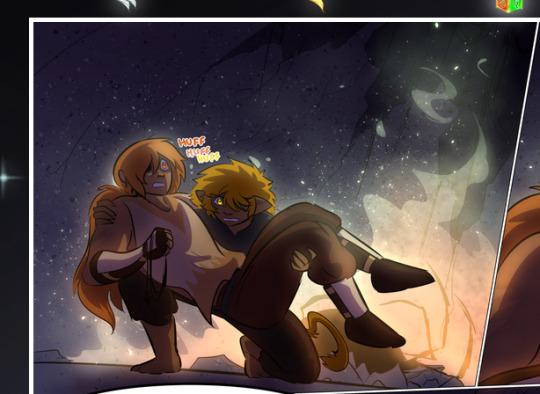
—where we now see that Falst's position is raised above Dainix's due to the way he's carrying him. (Points for continuity!) And, of course, we see the little "huffs" flowing from orange to yellow over their heads (where Dainix's head is higher than Falst's) to merge the sound of their breathing, which is absurdly clever because it emphasizes to the viewer how we hear two sets of huffing overlaying each other, not one. Absolutely brilliant.
(A few other notes of appreciation to that panel: beautiful glows around them, the sparks, the jagged silhouette of the spider legs, the lovely colors that have no right to make the area around a spider corpse that pretty, the excellent texturing on the cave walls plus perspective, the way Falst's movements imply Dainix's hefty weight, the natural posing of the characters, their on-point expressions that convey exactly how fuckin terrifying everything is right now, the slight glows to their eyes, and also they're just handsome boys <3)
Next up: Rain!!!! So well done! It's subtle enough that it never ever disrupts the impact of the focal point, but evident enough you can tell! And more importantly: THE MIST OFF THE CHARACTERS. Rain does this irl, it has that little vapor that comes off you and makes that little misty effect that plays with lighting, it's so cool-looking and here it's used to such pretty effect!
One of the panel captions says something about it blurring out all the injuries on the characters but like THAT AIN'T TOO BIG OF A PROBLEM when it gets across the environmental vibes, and also that'd be how it would look in real life too so like… outside viewer's angle is the same as the characters', mostly? my point is: that's the environment!!! that's the vibes, that's the feel! It gets it across and it does so in the most pretty way possible!
And another thing re: rain, the use of it to establish perspective, particularly in panels like this—

—where we can tell we're looking down at Tynan due to the perspective on the rain and where it's pointing. Excellent. (Also, kudos for looking down and emphasizing how Tynan's losing his advantage—lovely use of visual storytelling.)
Additionally, the misting here:
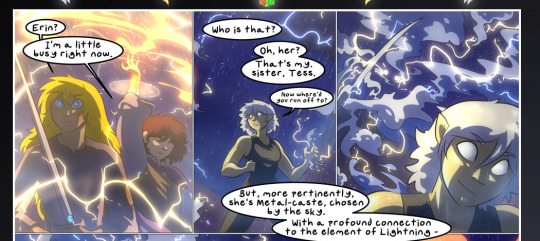
We see it most heavily in the leftmost panel, where it's quite foggy as you would expect in a rainstorm, especially in an environment with a lot of heat, but it's also lightly powdered on in the following two panels and tends to follow light sources, which makes complete sense given how light bounces off particles in the air.
A major point of strength in these too is a thorough understanding of lighting, like rim lighting, the various hues and shades, and an intricate understanding of how light bounces off surfaces even when they're in shadow (we'll see a faint glow in spots where characters are half in shadow, but that's how it would work in real life, because of how light bounces around).
Bringing some of these points together: the fluidity of the lines in magic, and the way simple glowing lines are used to emphasize motion and the magic itself, is deeply clever. I'm basically pulling at random from panels and there's definitely even better examples, but here's one (see this page https://comicaurora.com/aurora/1-16-33/):

First panel, listed in numbers because these build on each other:
The tension of the lines in Tess's magic here. This works on a couple levels: first, the way she's holding her fists, as if she's pulling a rope taut.
The way there's one primary line, emphasizing the rope feeling, accompanied by smaller ones.
The additional lines starbursting around her hands, to indicate the energy crackling in her hands and how she's doing a good bit more than just holding it. (That combined with the fists suggests some tension to the magic, too.) Also the variations in brightness, a feature you'll find in actual lightning. :D Additional kudos for how the lightning sparks and breaks off the metal of the sword.
A handful of miscellaneous notes on the second panel:
The reflection of the flames in Erin's typically dark blue eyes (which bears a remarkable resemblance to Dainix, incidentally—almost a thematic sort of parallel given Erin's using the same magic Dainix specializes in?)
The flowing of fabric in the wind and associated variation in the lineart
The way Erin's tattoos interact with the fire he's pulling to his hand
The way the rain overlays some of the fainter areas of fire (attention! to! detail! hell yeah!)
I could go on. I won't because this is a lot of writing already.
Third panel gets paragraphs, not bullets:
Erin's giant-ass "FWOOM" of fire there, and the way the outline of the word is puffy-edged and gradated to feel almost three-dimensional, plus once again using Screen or a variation on it so that the stars show up in the background. All this against that stunning plume of fire, which ripples and sparks so gorgeously, and the ending "om" of the onomatopoeia is emphasized incredibly brightly against that, adding to the punch of it and making the plume feel even brighter.
Also, once again, rain helping establish perspective, especially in how it's very angular in the left side of the panel and then slowly becomes more like a point to the right to indicate it's falling directly down on the viewer. Add in the bright, beautiful glow effects, fainter but no less important black lines beneath them to emphasize the sky and smoke and the like, and the stunningly beautiful lighting and gradated glows surrounding Erin plus the lightning jagging up at him from below, and you get one hell of an impactful panel right there. (And there is definitely more in there I could break down, this is just a lot already.)
And in general: The colors in this? Incredible. The blues and purples and oranges and golds compliment so well, and it's all so rich.
Like, seriously, just throughout the whole comic, the use of gradients, blending modes, color balance and hues, all the things, all the things, it makes for the most beautiful effects and glows and such a rich environment. There's a very distinct style to this comic in its simplified backgrounds (which I recognize are done partly because it's way easier and also backgrounds are so time-consuming dear gods but lemme say this) and vivid, smoothly drawn characters; the simplicity lets them come to the front and gives room for those beautiful, richly saturated focal points, letting the stylized designs of the magic and characters shine. The use of distinct silhouettes is insanely good. Honestly, complex backgrounds might run the risk of making everything too visually busy in this case. It's just, augh, so GORGEOUS.
Another bit, take a look at this page (https://comicaurora.com/aurora/1-15-28/):
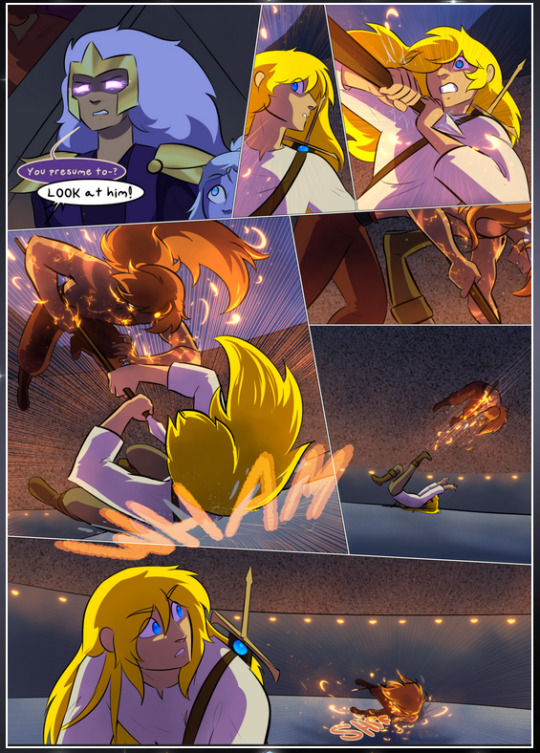
It's not quite as evident here as it is in the next page, but this one does some other fun things so I'm grabbing it. Points:
Once again, using different colors to represent different character actions. The "WHAM" of Kendal hitting the ground is caused by Dainix's force, so it's orange (and kudos for doubling the word over to add a shake effect). But we see blue layered underneath, which could be an environmental choice, but might also be because it's Kendal, whose color is blue.
And speaking off, take a look at the right-most panel on top, where Kendal grabs the spear: his motion is, again, illustrated in bright blue, versus the atmospheric screened-on orange lines that point toward him around the whole panel (I'm sure these have a name, I think they might be more of a manga thing though and the only experience I have in manga is reading a bit of Fullmetal Alchemist). Those lines emphasize the weight of the spear being shoved at him, and their color tells us Dainix is responsible for it.
One of my all-time favorite effects in this comic is the way cracks manifest across Dainix's body to represent when he starts to lose control; it is utterly gorgeous and wonderfully thematic. These are more evident in the page before and after this one, but you get a decent idea here. I love the way they glow softly, the way the fire juuuust flickers through at the start and then becomes more evident over time, and the cracks feel so realistic, like his skin is made of pottery. Additional points for how fire begins to creep into his hair.
A small detail that's generally consistent across the comic, but which I want to make note of here because you can see it pretty well: Kendal's eyes glow about the same as the jewel in his sword, mirroring his connection to said sword and calling back to how the jewel became Vash's eye temporarily and thus was once Kendal's eye. You can always see this connection (though there might be some spots where this also changes in a symbolic manner; I went through it quickly on the first time around, so I'll pay more attention when I inevitably reread this), where Kendal's always got that little shine of blue in his eyes the same as the jewel. It's a beautiful visual parallel that encourages the reader to subconsciously link them together, especially since the lines used to illustrate character movements typically mirror their eye color. It's an extension of Kendal.
Did I mention how ABSOLUTELY BEAUTIFUL the colors in this are?
Also, the mythological/legend-type scenes are illustrated in familiar style often used for that type of story, a simple and heavily symbolic two-dimensional cave-painting-like look. They are absolutely beautiful on many levels, employing simple, lovely gradients, slightly rougher and thicker lineart that is nonetheless smoothly beautiful, and working with clear silhouettes (a major strength of this art style, but also a strength in the comic overall). But in particular, I wanted to call attention to a particular thing (see this page https://comicaurora.com/aurora/1-12-4/):
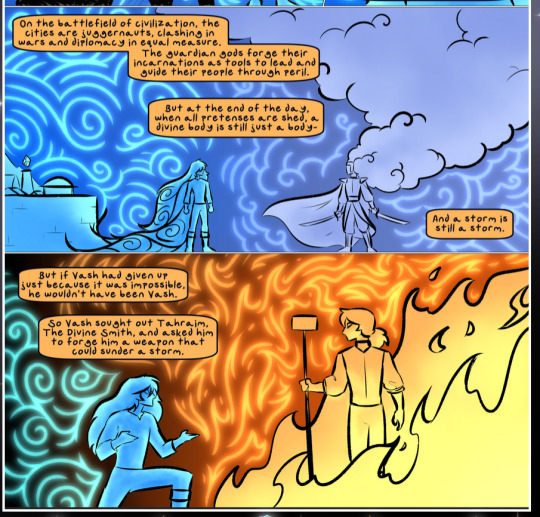
The flowing symbolic lineart surrounding each character. This is actually quite consistent across characters—see also Life's typical lines and how they curl:
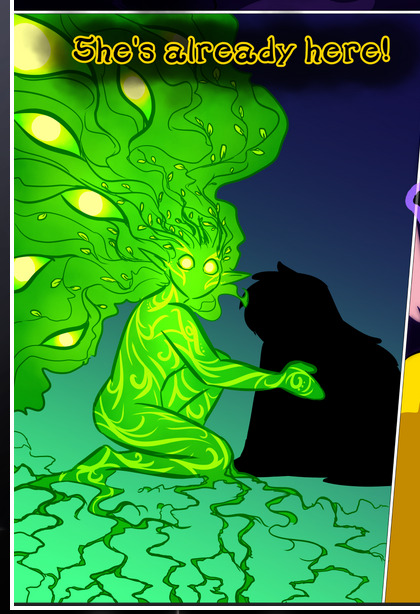
What's particularly interesting here is how these symbols are often similar, but not the same. Vash's lines are always smooth, clean curls, often playing off each other and echoing one another like ripples in a pond. You'd think they'd look too similar to Life's—but they don't. Life's curl like vines, and they remain connected; where one curve might echo another but exist entirely detached from each other in Vash's, Life's lines still remain wound together, because vines are continuous and don't float around. :P
Tahraim's are less continuous, often breaking up with significantly smaller bits and pieces floating around like—of course—sparks, and come to sharper points. These are also constants: we see the vines repeated over and over in Alinua's dreams of Life, and the echoing ripples of Vash are consistent wherever we encounter him. Kendal's dream of the ghost citizens of the city of Vash in the last few chapters is filled with these rippling, echoing patterns, to beautiful effect (https://comicaurora.com/aurora/1-20-14/):
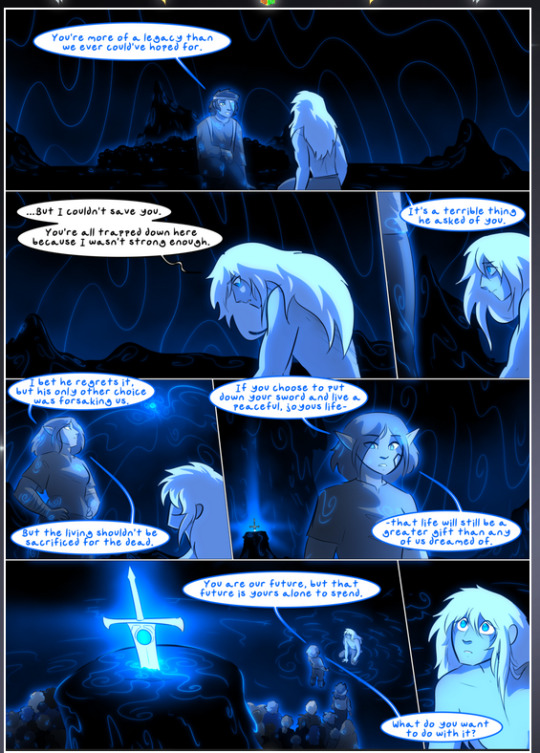
They ripple and spiral, often in long, sinuous curves, with smooth elegance. It reminds me a great deal of images of space and sine waves and the like. This establishes a definite feel to these different characters and their magic. And the thing is, that's not something that had to be done—the colors are good at emphasizing who's who. But it was done, and it adds a whole other dimension to the story. Whenever you're in a deity's domain, you know whose it is no matter the color.
Regarding that shape language, I wanted to make another note, too—Vash is sometimes described as chaotic and doing what he likes, which is interesting to me, because smooth, elegant curves and the color blue aren't generally associated with chaos. So while Vash might behave like that on the surface, I'm guessing he's got a lot more going on underneath; he's probably much more intentional in his actions than you'd think at a glance, and he is certainly quite caring with his city. The other thing is that this suits Kendal perfectly. He's a paragon character; he is kind, virtuous, and self-sacrificing, and often we see him aiming to calm others and keep them safe. Blue is such a good color for him. There is… probably more to this, but I'm not deep enough in yet to say.
And here's the thing: I'm only scratching the surface. There is so much more here I'm not covering (color palettes! outfits! character design! environment! the deities! so much more!) and a lot more I can't cover, because I don't have the experience; this is me as a hobbyist artist who happened to take a couple design classes because I wanted to. The art style to this comic is so clever and creative and beautiful, though, I just had to go off about it. <3
...brownie points for getting all the way down here? Have a cookie.
#aurora comic#aurora webcomic#comicaurora#art analysis#...I hope those are the right tags???#new fandom new tagging practices to learn ig#much thanks for something to read while I try to rest my wrists. carpal tunnel BAD. (ignore that I wrote this I've got braces ok it's fine)#anyway! I HAVE. MANY MORE THOUGHTS. ON THE STORY ITSELF. THIS LOVELY STORY#also a collection of reactions to a chunk of the comic before I hit the point where I was too busy reading to write anything down#idk how to format those tho#...yeet them into one post...???#eh I usually don't go off this much these days but this seems like a smaller tight-knit fandom so... might as well help build it?#and I have a little more time thanks to break so#oh yes also shoutout to my insanely awesome professor for teaching me all the technical stuff from this he is LOVELY#made an incredibly complex program into something comprehensible <3#synapse talks
806 notes
·
View notes
Text
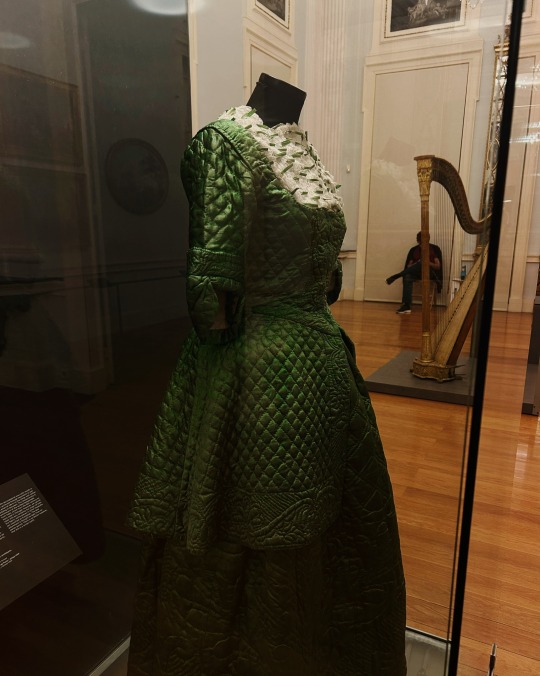
A dress and jacket ensemble, National Museum Soares dos Reis (my photo).
A few days past, whilst sifting through my phone’s gallery, I chanced upon this photograph. I do believe I have ever truly shared this ensemble (well, at least not here) though I distinctly recall how struck I was by its design, which seemed rather uncommon for the mid-18th century.
The technique employed is of particular interest: the fabric is adorned with a composition of vegetal motifs, realised by means of quilting. This method, whereby the outer silk satin is joined to an inner cotton lining using backstitching, is further enriched with padding, grsting the piece its singularly textured, quilted appearance.
Though I lack a photograph displaying the full frontal perspective of the ensemble, the jacket features a tailored waistline from which extends a pronounced peplum, elegantly overlapping the skirt down to the hip. The skirt itself is cut straight and gathered at the waist, generously draping over the internal structure (the so-called “panniers”) that defined 18th century fashion silhouettes. About its height, I possess no precise information by which to ascertain it; yet, drawing upon memory alone, I seem to recall it stood at roughly my own stature (1,56m/5.12 feet).
Indeed, other garments from the same period are known to exhibit similar quilted techniques. However, what renders this piece so distinctive is, in all likelihood, the chromatic impression created by the fabric’s hue. One plausible explanation lies in the use of Indian-made coverlets, which Portugal had imported in considerable quantity since the 16th century (still, the precise origin of the textile remains uncertain). While the hypothesis of an indian provenance cannot be entirely ruled out, it is also worth noting the existence of english examples bearing comparable designs.
4 notes
·
View notes
Text
Unlocking the Magic of Custom Cotton Muslin Fabric: Versatile, Sustainable, and Chic

If you're a creator, designer, or DIY enthusiast, you've likely stumbled across custom cotton muslin fabric in your search for the perfect material. This humble textile is having a major moment, and for good reason. Its lightweight, breathable, and endlessly adaptable nature makes it a go-to for everything from fashion to home décor. But what exactly makes muslin so magical? Let's dive into why this fabric is a game-changer, blending versatility, sustainability, and a chic edge that's impossible to ignore.
The Versatility of Muslin Printed Fabric
Muslin's charm lies in its ability to be anything you want it to be. Whether you are crafting flowy dresses, cozy quilts, or statement curtains, muslin printed fabric offers a soft, slightly textured canvas that holds color beautifully. Its natural weave gives designs a rustic yet refined look, perfect for both minimalist and bold aesthetics. At Prinstitch, we've seen creators transform muslin into everything from baby swaddles to artisanal tote bags, proving its unmatched flexibility. The fabric's open weave also makes it ideal for layering, draping, or even experimental dyeing techniques, giving you endless creative freedom.
Sustainability Meets Style
In a world increasingly focused on eco-conscious choices, muslin stands out as a sustainable superstar. Made from natural cotton, custom cotton muslin fabric is biodegradable and often sourced from renewable crops. Its production requires less water and energy compared to synthetic fabrics, making it a favorite for environmentally minded designers. Plus, muslin's durability means your creations last, reducing the need for fast fashion or disposable décor. By choosing muslin, you're not just crafting something beautiful - you're making a statement about sustainability without sacrificing style.
The Rise of Digital Printed Muslin Fabric
One of the most exciting developments in muslin's modern renaissance is digital printed muslin fabric. This cutting-edge technology allows for vibrant, high-resolution designs that bring your vision to life with stunning precision. Unlike traditional printing methods, digital printing offers limitless color palettes and intricate patterns, from florals to geometric abstracts. It's perfect for small-batch projects or one-of-a-kind pieces, as it eliminates the need for costly setups. Whether you are a designer launching a capsule collection or a hobbyist creating custom gifts, digital printing on muslin elevates your work to professional levels.
Mastering Print Design on Fabric
The key to unlocking muslin's potential lies in thoughtful print design on fabric. A well-chosen design can transform a simple piece of muslin into a showstopper. Think bold botanical motifs for summer dresses or subtle textures for throw pillows. The beauty of muslin is its ability to let prints shine without overwhelming the senses. For those looking to scale their projects, custom fabric printing wholesale options make it easy to access high-quality muslin in bulk, ensuring consistency across larger collections.
Why Muslin Is Your Next Must-Have
So, why should you add custom printed cotton muslin fabric to your creative arsenal? It's versatile enough to suit any project, sustainable enough to align with eco-conscious values, and chic enough to make a statement. Its light feel, combined with the endless possibilities for printing designs on it, makes it a fabric that is both practical and inspiring. Ready to unlock its magic? Your next masterpiece is just one step away.
2 notes
·
View notes
Text
Can You Learn to Sew Online? A Comprehensive Look at Your Options with ONSA
At ONSA - Online Sewing Academy, the world of stitching and garment construction should be accessible to everyone, regardless of location or schedule. In today's digital age, online learning has revolutionized how we acquire new skills, making it possible to master intricate crafts like sewing from the comfort of our homes. But can you truly become an expert stitcher through virtual classes alone? Let's explore the options available and how ONSA empowers you to embark on an enriching sewing journey.
The Beauty of Pre-Recorded Video Lessons
Ah, the world of pre-recorded tutorials - a treasure trove of knowledge at your fingertips! ONSA's extensive library of meticulously crafted video lessons offers a comprehensive exploration of sewing techniques, from the fundamentals of threading a needle to the intricacies of advanced garment construction. One of the most significant advantages of this format is the ability to learn at your own pace, rewinding and revisiting lessons as many times as needed until each stitch and seam becomes second nature.
Our pre-recorded videos are thoughtfully designed to cater to diverse learning styles, combining visual demonstrations with clear, concise explanations. Whether you're a visual learner who thrives on observing each step or an auditory learner who appreciates detailed verbal guidance, our lessons ensure that no aspect of the sewing process is left unexplained.
While budget-friendly and convenient, we understand that pre-recorded content may lack the human interaction that many pupils crave – the ability to ask questions, receive real-time feedback, and benefit from the personalized attention of an experienced instructor. This is where our live, interactive classes come into play.
The Magic of Live, Interactive Classes
Imagine having a seasoned ONSA instructor by your virtual side, guiding you through the intricate sewing world with patience and expertise. Our live, online classes provide an immersive, interactive experience replicating the intimacy of a physical classroom setting. Through video conferencing technology, you can follow along with your instructor, ask questions as they arise, and receive real-time feedback on your technique.
One of the most significant advantages of live classes at ONSA is the ability to learn at a pace that suits your individual needs. Our instructors are adept at adapting their teaching methods to accommodate varying skill levels, ensuring that every student feels included and supported. Whether you're a complete novice taking your first tentative stitches or a skilled stitcher seeking to elevate your art, our talented teachers can customize lesson plans to align with your unique goals and aspirations.
From mastering the art of inserting invisible zippers to acquiring advanced draping skills for haute couture designs, our live classes cover various topics, catering to hobbyists and aspiring professionals. Private one-on-one sessions and small group workshops provide ample opportunity for personalized guidance, fostering an environment where questions are welcomed, and challenges are addressed with patience and expertise.
The ONSA Edge: A Holistic Approach to Sewing Education
At ONSA, we understand that sewing is more than just a practical skill – it's an art form that combines technical precision with creative expression. Our approach to online sewing education is rooted in this philosophy, nurturing both the technical and artistic aspects of this timeless craft.
Our team of expert instructors, each with years of industry experience and a passion for teaching, has thoughtfully crafted a multifaceted curriculum that covers the entire spectrum of sewing, from understanding fabric properties and pattern drafting to mastering advanced construction techniques and exploring fashion design principles.
By combining our comprehensive library of pre-recorded video resources with live, interactive sessions, ONSA provides a 360-degree learning experience tailored to your schedule, skillset, and aspirations. Whether you prefer the convenience of self-paced learning or thrive on the dynamic energy of a virtual classroom, our blend of educational formats ensures that your sewing journey is enriching, engaging, and tailored to your unique needs.
Beyond the technical aspects of sewing, ONSA also emphasizes the importance of nurturing creativity and self-expression. Our lessons encourage students to experiment with fabric choices, color combinations, and design elements, fostering an environment where individuality is celebrated and personal style is cultivated.
Sewing Mastery: A Journey, Not a Destination
At ONSA, we firmly believe that sewing mastery is a lifelong pursuit, a continuous learning and refinement journey. Our online academy is designed to support you at every stage of this journey, from your first tentative stitches to the creation of intricate, couture-worthy garments.
As you progress through our curriculum, you can participate in virtual sewing circles, where you can connect with fellow stitchers, share your creations, and seek inspiration from a community of like-minded individuals. Our instructors are not just teachers but mentors dedicated to your growth and success, offering guidance and encouragement every step of the way.
Sewing is more than just a hobby – it's a powerful form of self-expression, transforming fabric into wearable art that reflects your unique style and personality. At ONSA, we strive to empower you to unleash your creativity, one stitch at a time, by providing a comprehensive and immersive online learning experience tailored to your needs.
Ready to Start Stitching Your Dreams into Reality?
Whether you're a busy professional seeking a creative outlet, a stay-at-home parent looking to explore a new passion, or a lifelong stitcher yearning to elevate your skills, ONSA - Online Sewing Academy supports your sewing journey.
Explore our diverse online sewing courses today, from beginner-friendly introductions to advanced masterclasses, and unlock a world of possibilities that transcends time and space. With ONSA, the art of sewing is no longer limited by your location or schedule – it's a vibrant, accessible realm where your dreams can be woven into reality, one exquisite thread at a time.
Join our virtual community of passionate stitchers, where inspiration, camaraderie, and personal growth intertwine seamlessly. Embark on a transformative journey that will teach you sewing techniques, ignite your creativity, boost your confidence, and empower you to express your individuality through the timeless art of garment construction.
The world of sewing awaits, and at ONSA, we're committed to being your trusted guide every step of the way. Unleash your inner stitching prowess, and let your creativity take flight – the possibilities are endless.
#sewing#sewing classes#online sewing classes#learn to sew online#virtual sewing lessons#sewing tutorials#pre-recorded sewing videos#live sewing classes#interactive sewing instruction#ONSA sewing academy#sewing education#sewing mastery#garment construction#fashion design#pattern drafting#sewing techniques#creative sewing#sewing community#sewing journey#sewing skills#beginner sewing#advanced sewing#couture sewing#self-paced learning#personalized instruction#sewing mentorship#sewing creativity#sewing expression#wearable art#fabric art
16 notes
·
View notes
Text
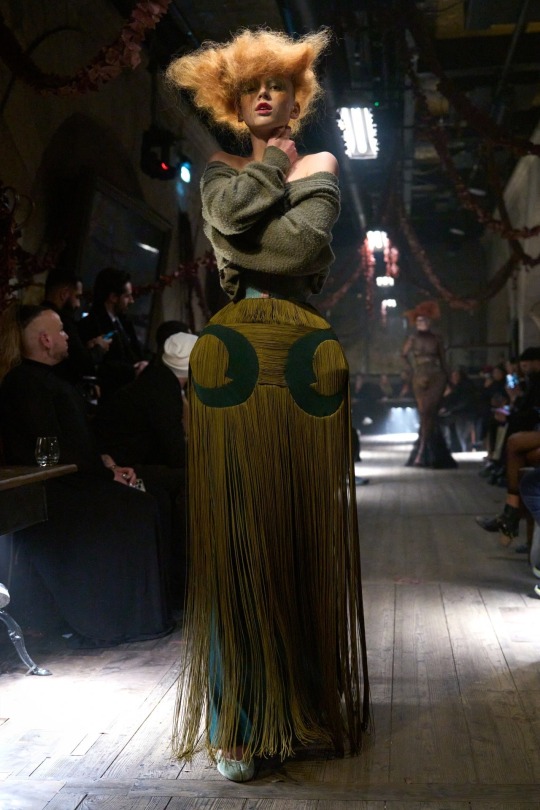
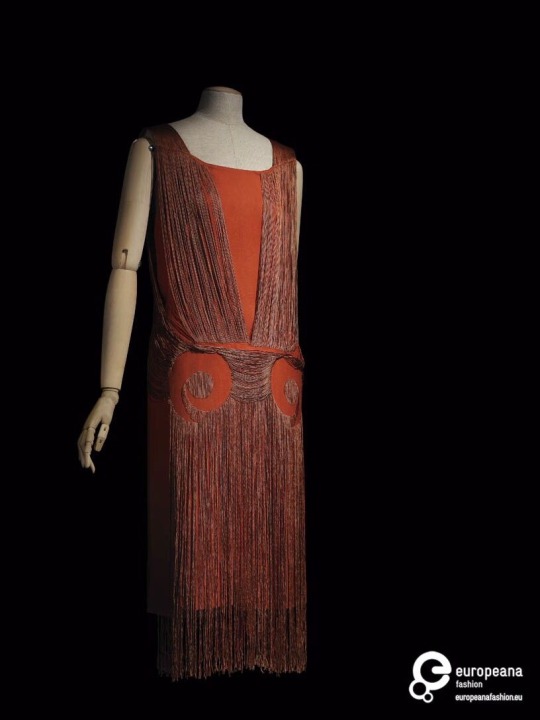
• Maison Margiela Artisanal 2024 Collection by John Galliano, Look 7.
• Evening gown made of silk fringe and spiral motif embroidery, 1925, by Madeleine Vionnet.
Madeleine Vionnet, was a French designer who opened her first fashion house in Paris in 1912, surviving both World Wars even after being forced to close during the First and Second war. Vionnet would use materials such as satin, gabardine and crêpe de chine that were uncommon for the 1920s and 1930s. She became the pioneer of the ‘bias cut’, a technique of cutting cloth against the grain of the fabric, allowing it to drape beautifully to the body and move with the wearer.
Madeleine Vionnet has been credited for inspiring numerous modern designers, especially John Galliano. She has been an inspiration of his since his Spring/Summer collection in 1989, where he adopted her ingenious technique of the bias cut, pushing slip dresses with the bias cut to the forefront of 1990s evening wear in fashion.
Galliano references back to the iconic work of Vionnet in this look on the runway, with many similarities to the evening gown she made in 1925. The evening gown consists of a bright red silk dress with fringe, that drapes to the waist and then flows down past the seam of the dress, and spiral motif embroidery on the hips. Galliano followed the same method but designed a skirt instead - a satin-back crêpe skirt in bottle-green with embellished metallic bronze fringe that falls to the floor and crescent moon motif embroidered on the hips.
Follow and keep your notifications on for more posts on this current Margiela collection and other runway, art, film and media references!
Sources:
Maison Margiela Artisanal 2023 Collection Look 7 image: https://theimpression.com/maison-margiela-spring-2024-couture-fashion-show-review/
Evening gown by Madeleine Vionnet image: https://www.europeana.eu/en/item/2048218/europeana_fashion_UF_86_70_4
#maison margiela#john galliano#madeleine vionnet#artisanal collection#2024#1920s fashion#fashion#history#women’s fashion#innovative#iconic women#design
8 notes
·
View notes
Text
Benefits of Wearing a Saree
The saree is more than just a piece of clothing; it is a symbol of grace, tradition, and versatility that has stood the test of time.
Spanning centuries and cultures, this quintessential Indian garment has evolved into a fashion statement worldwide.
Whether adorned by grandmothers at traditional ceremonies or flaunted by millennials at glamorous events, the saree continues to hold its place as an iconic piece of attire.
But beyond its aesthetic appeal, there are numerous benefits to wearing a saree. Let us explore the advantages that make this attire truly exceptional.

1. Timeless Elegance and Versatility
One of the most significant benefits of wearing a saree is its unmatched elegance.
A saree effortlessly combines traditional charm with contemporary style. Available in countless fabrics, designs, and colors, it caters to every occasion—be it a wedding, a casual gathering, or a professional meeting.
The versatility of a saree lies in its adaptability; you can drape it differently to achieve various looks.
From the classic Nivi style to the regal Bengali drape, each method of wearing a saree imparts a unique aesthetic.
2. Celebration of Cultural Heritage
Wearing a saree is a beautiful way to honor and preserve cultural heritage.
Every region in India has its distinct style of saree, such as the Banarasi silk from Uttar Pradesh, Kanjeevaram from Tamil Nadu, and Chanderi from Madhya Pradesh. Each type reflects the artistry, craftsmanship, and history of its place of origin. By wearing sarees, we not only connect with our roots but also contribute to keeping age-old traditions alive.
3. Flattering for All Body Types
The saree is one of the few garments that suit every body type. Its fluid and adjustable nature allows it to drape seamlessly over any figure, enhancing the wearer’s natural beauty.
Whether you have a petite frame or a curvaceous body, a saree can be styled to highlight your best features. Unlike western attire, which often adheres to rigid sizing standards, a saree embraces individuality, offering a custom fit every time.
4. Promotes Handcrafted Textiles and Sustainable Fashion
In an age dominated by fast fashion, sarees stand out as sustainable and eco-friendly clothing.
Many sarees are handcrafted using natural fibers like cotton and silk, supporting local artisans and weavers.
By choosing handwoven sarees, you contribute to sustainable fashion practices and help preserve traditional craftsmanship.
Additionally, sarees are durable and timeless, reducing the need for frequent replacements, which is a hallmark of environmentally conscious fashion.
if you want to buy best saree visit here: silver squre
5. Boosts Confidence and Poise
There’s something about wearing a saree that instantly elevates one’s confidence.
The graceful drape and flowing pleats lend an air of sophistication and poise to the wearer.
It is no wonder that women often choose sarees for milestone events like weddings, graduation ceremonies, and award functions.
The saree’s ability to make the wearer feel elegant and powerful is unmatched.
6. Enhances Femininity
The saree is synonymous with femininity. Its design accentuates curves while maintaining a sense of modesty, making it a perfect blend of sensuality and sophistication.
Accessories like bangles, jhumkas, and necklaces further enhance the look, allowing women to embrace and celebrate their feminine side.
7. Comfort and Breathability
Contrary to popular belief, sarees can be incredibly comfortable to wear, especially when made from breathable fabrics like cotton or linen.
During hot summers, light cotton sarees provide excellent ventilation, keeping the wearer cool. Similarly, silk and woolen sarees offer warmth during colder months.
Unlike fitted western outfits, sarees offer ease of movement and comfort, making them suitable for long hours of wear.
8. Expression of Individuality
A saree allows endless opportunities for personalization and self-expression. From choosing the fabric and color to pairing it with unique blouses and accessories, a saree reflects the wearer’s personality.
Modern interpretations of the saree include pairing it with crop tops, jackets, or even sneakers, proving that it is not bound by conventional styling rules.
9. Universal Appeal Across Generations
The saree transcends age barriers. It is as relevant to a young woman attending her first college cultural event as it is to an elderly lady gracing a family function.
This universal appeal ensures that the saree remains a staple in every Indian wardrobe. Additionally, its ability to adapt to changing fashion trends while retaining its essence makes it a beloved choice across generations.
10. Practical and Long-Lasting
A saree, if cared for properly, can last for decades, often becoming a family heirloom passed down through generations. Its longevity and timeless appeal make it a practical investment.
Moreover, sarees are easy to store and require minimal maintenance, especially those made from durable fabrics like cotton and silk.
Conclusion
Wearing a saree is more than a fashion choice; it is an experience that connects you to culture, tradition, and individuality.
Its elegance, versatility, and sustainability make it a garment like no other. Whether you are attending a formal event, celebrating a festival, or simply embracing your heritage, a saree is a perfect choice.
By draping a saree, you don’t just wear a piece of fabric; you carry forward a legacy of art, grace, and timeless beauty. So, the next time you open your wardrobe, consider the saree—a garment that’s as multifaceted as the women who wear it.
2 notes
·
View notes
Text
Types of Ladies' Suits: Styles That Suit Every Occasion

The world of women’s fashion has always been a fascinating blend of tradition and modernity. Among the most versatile and stylish wardrobe essentials are suits, which have evolved to cater to diverse preferences and occasions. With countless suit designs for ladies, women today can choose styles that reflect their personality and meet the demands of different events. Interestingly, just as sarees come with various draping methods, the concept of suits too offers unique variations that ensure there’s something for everyone. Exploring these options can be as delightful as understanding the different types of saree wearing, both offering endless opportunities for self-expression.
Classic Suit Designs for Ladies
1. Pantsuits
Pantsuits are the epitome of elegance and functionality, making them a popular choice for professional and semi-formal settings. With tailored trousers and matching blazers, this design offers a polished look that never goes out of style. Variations include wide-leg, slim-fit, and cropped trousers, ensuring versatility for every body type.
2. Skirt Suits
Combining femininity with sophistication, skirt suits pair fitted blazers with skirts of various lengths. Pencil skirts are ideal for corporate environments, while flared or pleated skirts add a playful touch for more relaxed occasions.
3. Tunic and Trouser Suits
Inspired by traditional ethnic wear, tunic and trouser suits are a blend of comfort and elegance. This style is particularly popular in regions where cultural elements influence daily fashion. It’s a great option for formal gatherings or festive events.
4. Tuxedo Suits
For a bold and statement-making look, tuxedo suits are an excellent choice. Featuring satin lapels and sleek silhouettes, these suits are perfect for evening parties or formal galas. Pair them with heels or statement jewelry for a glamorous finish.
5. Casual Suits
Casual suits feature relaxed cuts and lightweight fabrics, making them ideal for brunches, vacations, or creative workspaces. They often come in vibrant prints and pastel shades, reflecting a laid-back yet stylish vibe.
Modern Variations of Ladies' Suits
1. Jumpsuit Suits
A modern take on traditional suits, jumpsuit suits combine the ease of one-piece clothing with the sophistication of tailored designs. These suits are perfect for cocktail parties, date nights, or semi-formal events.
2. Belted Suits
Adding a belt to a classic suit elevates its structure and draws attention to the waistline. This modern twist works well for both office wear and stylish daywear.
3. Printed Suits
For those who love to stand out, printed suits in floral, geometric, or abstract patterns bring a vibrant energy to the outfit. They are ideal for outdoor events, creative workplaces, or fashion-forward gatherings.
4. Cape Suits
Cape suits add a dramatic flair to traditional tailoring. With a flowing cape attached to the blazer or as a separate piece, this style is perfect for weddings, red carpets, or special occasions.
5. Eco-Friendly Suits
Sustainable fashion is on the rise, and eco-friendly suits crafted from organic fabrics or recycled materials are becoming a favorite among conscious consumers. These suits are stylish, environmentally friendly, and aligned with modern values.
Styling Tips for Ladies' Suits
Accessorize Thoughtfully: Accessories such as bold necklaces, elegant earrings, or a statement clutch can elevate your suit’s overall appeal.
Experiment with Shoes: From stilettos to sneakers, the right footwear can transform the look of your suit.
Play with Colors and Textures: Don’t hesitate to explore unconventional shades or pair textured fabrics for a unique outfit.
Layer Creatively: Add scarves, turtlenecks, or even crop tops beneath blazers for a fresh take on classic designs.
A Cultural Parallel: Sarees and Suits
The versatility of suits for ladies draws an interesting parallel with sarees. Just as there are different types of saree wearing, each with its own cultural and regional identity, suits too offer a range of designs to suit varied tastes and occasions. While sarees reflect traditional elegance, suits often merge modern trends with classic tailoring. Together, these garments celebrate the diversity and richness of women’s fashion.
Why Suits are a Timeless Choice
Suits for ladies are no longer confined to boardrooms or formal settings. They’ve become a canvas for creative expression, blending traditional craftsmanship with contemporary trends. Whether you’re looking for a professional ensemble, a glamorous party outfit, or a casual yet chic attire, the wide array of suit designs for ladies ensures there’s always an option that fits your needs.
Final Thoughts
Fashion is about versatility, and ladies' suits epitomize this concept beautifully. From pantsuits to jumpsuit designs, each style reflects the evolving role of women in society while honouring their unique preferences. Like the different types of saree wearing, the variety in suit designs ensures there’s always room for individuality and experimentation. Whether for work, a celebration, or casual outings, finding the perfect suit is a journey worth embracing—one that merges timeless elegance with modern flair.
2 notes
·
View notes
Text
Exploring Different Styles of Garment Construction
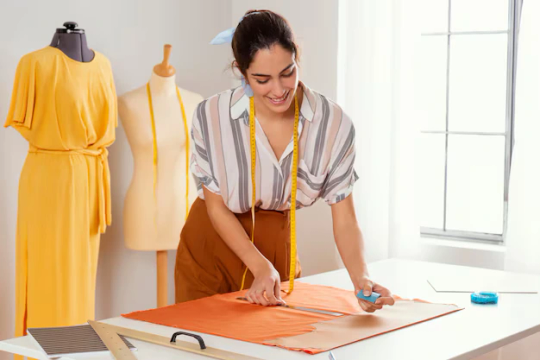
Garment construction is a fascinating blend of art, technique, and creativity. It involves transforming raw materials into wearable designs through various methods, stitches, and fabric manipulation techniques. Understanding different styles of garment construction is essential for fashion designers and sewing enthusiasts who want to create unique, high-quality pieces. In this guide, we'll dive into the most popular garment construction techniques, exploring how each style contributes to a garment's fit, appearance, and durability.
1. Flat Pattern Construction
Flat pattern construction is one of the most widely used techniques in the fashion industry. It involves creating a garment by drafting and cutting patterns from basic measurements, then assembling these patterns to form the final piece.
How It Works: Flat patterns are drawn on paper or digital software and serve as templates for cutting the fabric. The patterns are then traced onto fabric and cut before being sewn together. Benefits: Precision and Fit: Since the patterns are created based on specific body measurements, flat pattern construction can result in well-fitted garments. Versatility: Flat pattern construction is highly adaptable, making it suitable for everything from dresses to outerwear.
2. Draping Technique
Draping is a more natural way to make clothes, where a pattern is made by pinning and manipulating fabric directly on a dress form. This technique allows designers to see how the fabric drapes and falls on a body-like shape, which is useful for creating unique, custom-fitted pieces.
How It Works: Designers pin the fabric onto a dress form, creating shapes and folds until the desired silhouette is achieved. The fabric is then marked, removed, and used as a pattern for cutting. Benefits: Freedom of Creativity: Draping allows for more spontaneous design choices and can lead to innovative silhouettes and styles. Enhanced Flow and Shape: This technique is ideal for designs that require fluid movement and organic shapes, like evening gowns or asymmetrical tops.
3. Tailoring and Structured Garments
Tailoring is a garment construction technique focused on creating structured, fitted garments, commonly used for suits, coats, and other formalwear. Tailored garments are known for their attention to detail and sharp lines, providing a polished and professional look.
How It Works: Tailoring involves a precise measurement process, often adding padding, interfacing, and shaping to provide structure. This technique also uses specific stitches, such as pad stitching, to add durability and support to areas like lapels and collars. Benefits: Sharp Fit: Tailoring ensures garments fit closely to the body, which enhances the garment's overall aesthetic. Durability: Tailored pieces are designed to withstand wear, often becoming wardrobe staples due to their high quality and timeless appeal.
4. Knitting and Crochet Garment Construction
While often seen as separate crafts, knitting and crochet are also styles of garment construction that create unique, textured fabrics. Unlike traditional sewing, knitting and crochet build garments stitch by stitch, forming patterns with yarn rather than fabric.
How It Works: A single hook is used in crochet, whereas two needles are used in knitting to make interlocking loops. Patterns are followed to create sweaters, scarves, hats, and even dresses. Benefits: Texture and Warmth: Knitting and crochet add texture, making them ideal for creating cozy, cold-weather pieces. Customizability: These techniques allow for intricate patterns and custom designs, perfect for one-of-a-kind garments.
5. Hand Sewing and Couture Techniques
Hand sewing techniques are often used in couture garment construction, where each piece is meticulously crafted for luxury and exclusivity. This technique relies on hand stitches for detailing, embellishments, and finishings that can’t be achieved by machine.
How It Works: Couture involves techniques like hand basting, slip stitching, and hemming by hand to achieve flawless seams and finishes. Embellishments such as beads, sequins, and embroidery are often added by hand to enhance the garment. Benefits: Attention to Detail: Hand sewing offers unmatched precision, often resulting in high-end garments that showcase exceptional craftsmanship. Unique and Personalized: Each hand-sewn garment can be customized with intricate details, making it one-of-a-kind.
6. Zero-Waste Garment Construction
Zero-waste garment construction is an eco-conscious approach where the goal is to minimize fabric waste. Patterns are designed to use every inch of fabric, reducing the environmental impact of the garment-making process.
How It Works: In order to eliminate fabric waste, designers create patterns that fit together like puzzle pieces, Sometimes, unconventional shapes and designs are created to accommodate the zero-waste pattern. Benefits: Sustainability: Zero-waste construction aligns with eco-friendly values, addressing the issue of textile waste in fashion. Creative Design: This technique encourages creativity in pattern-making, resulting in distinctive, often asymmetrical styles.
7. Upcycling and Reconstruction

Upcycling involves taking old or discarded garments and reconstructing them into new designs. This technique has gained popularity as a sustainable approach to fashion, promoting creativity and environmental consciousness.
How It Works: Designers deconstruct an existing garment and use its fabric, buttons, zippers, and other elements to create something new. This can involve cutting, resewing, dyeing, or adding embellishments to give the garment a fresh look. Benefits: Eco-Friendly: Upcycling reduces textile waste, making it a sustainable fashion choice. Unique and Personalized: Each upcycled garment is unique, with its own character and story.
Final Thoughts
The different styles of garment construction each bring unique benefits and creative possibilities to fashion design. Whether you’re drawn to the structured elegance of tailoring or the freeform creativity of draping, understanding these techniques can elevate your skills and broaden your design capabilities. Each method reflects a different facet of the art and science of garment making, helping you create pieces that are not only beautiful but meaningful.
2 notes
·
View notes
Note
IVE SEEN A FEW OF UR RECENT POSTS AB TAILOR!READER SO I HOPE ITS OK FOR ME TO COME IN AND DROP SOME RAMBLING !!
firstly, is the tailor!reader exclusive to mondstadt or do you think they'd ever travel to other nations? because omg the thoughts . . .
kaveh making excuses to meet up with the tailor for the umpteenth time that week before they return to mondstadt - ranging from "alhaitham's headphones snagged my scarf!" "cyno got a little competitive over the last tcg game.." always blaming the others in an attempt to get pity from reader 😭 dehya making (repetitive) small talk about weather (or makeup) with reader in order to soothe her nerves and an attempt to conceal the shakiness of her voice and the reddening of her cheeks. nilou inviting them to as many performances as she can manage before reader leaves for mondstadt, wanting to show how much she loves the outfits they designed for her !! or thoma meeting up with reader to discuss fabrics and sewing techniques and ayato begins to take a small interest in reader as he watches his loyal servant blush and ramble from afar. or ayaka finding comfort in the times they visit because of how well they listen to not only her attire needs but her interests and what she's been up to. she just hopes her occasional stutter doesn't give away how flustered she is !! visiting liyue AND OHMYGOD NINGGUANG good lord so much I could say about her, i dont even know where to begin. . . AND YELAN??? poor tailor!reader is going to faint within minutes of being in their presence ^^; and omg sneaky hu tao purposely ruining her clothes so reader is forced to schedule spontaneous appointments to fix the clothes, or her playing small pranks on them for the time that they are visiting !!! and finally returning home to mondstadt, only to see your co workers tired and drained from dealing with the tense atmosphere along with stiff and curt responses from your normally lively, polite, and/or chatty clients </3 and telling kaeya, jean, rosaria, albedo, etc., all about your travels in the other nations and all the lovely and interesting people you met; ignorant to the way the corners of their lips tug down or push into a pout, the slight eyeroll you barely miss, the minor twitches of their fingers when you make a comment on wanting to travel again . . . AAA I love the concept of mondstadt tailor!reader <3
OHH i have not thought of them beyond mondstadt but it's certainly possible; sometimes one needs to travel for new fabrics and notions themselves, because buying from merchants is becoming too cost prohibitive or they just aren't bringing the kind of things you want - sometimes it's nice to see fashion in other nations, to talk about fontaine's new silhouettes or the beautiful silk of liyue or the fascinating dye methods of inazuma, to be able to outfit your mondstadt customers for their adventures outside of the city of freedom too--
and all of these other characters from other nations growing charmed by tailor reader, their smile and their gentle clever hands and their innate eye for design and cut and fabric, their occasional fumbles when they get flustered . . . how cute. they have to invite you again sometime. ningguang who wants a dress for a new ball and for you to outfit beidou appropriately too. ayato who calls you in on the pretense of new clothes for ayaka, kaveh who can't help spend his meagre money on beautiful things. a fatui harbinger who loves luxury and excess and notes your prowess on one of his business trips and wonders what you could drape him in, given half the chance . . .
better take someone for protection to that one.
24 notes
·
View notes
Text

“Neon Forest”, 2023

“Neon Forest”, 2023, another view

“Red Falls”, 2021
Above are sculptures by Akiko Kotani for the 2023 Florida Prize in Contemporary Art at Orlando Museum of Art.
Kotani’s Red Falls was part of Skyway 20/21 at USF Contemporary Museum, but it was a joy to see it again along with the 2023 sculptures White Falls and Neon Forest.
The museum’s information on the artist and her work-
As a young aspiring artist living in New York, Akiko Kotani discovered the expressive power of textile art while taking a weaving class at the YMCA Manhattan Weaving Workshop. The experience was life changing, leading her to continue her studies in Guatemala, a country with an exceptional textile art tradition. After two years in Guatemala, she returned to the United States to complete her MA in textiles at the Tyler School of Art in 1977.
In 1977 textiles were only beginning to achieve the status as an art form that they currently have in the contemporary art world. At the time the medium was widely associated with traditional and domestic crafts or as part of the fashion and décor industries. That view was starting to change, as demonstrated by the Metropolitan Museum of Art’s acquisition of one of Kotani’s works shortly after her graduation from Tyler. Since then, she has had a distinguished career as an artist exploring a variety of textile practices.
Kotani had been searching for ways to expand the scale of her work when in 2011 she received a grant from the Heinz Endowments and Pittsburgh Foundation which enabled her to pursue that ambition. The result was her first monumentally scaled sculpture, Soft Walls, a precursor of the works seen in the Florida Prize exhibition. Kotani has always used simple and direct methods of weaving and stitching to create her works. For Soft Walls she adopted a loosely woven crochet technique to produce long bands of material cut from white plastic garbage bags. Those bands were then combined to cover large free-standing walls. Kotani’s massive blocks of woven plastic have the elegant simplicity of minimalist sculpture, while the irregular knotting and soft, slumping fabric undermine the austere formalism of the work’s rectilinear shape.
Kotani’s process of crocheting plastic bags and other materials into long bands is an innovative development that has allowed her to create a variety of large-scale sculptural forms. White Falls and Neon Forest use these crocheted bands, draped in different ways to make sophisticated minimalist statements. Both sets of works are made livelier by how they respond to light. The thin plastic of White Falls shimmers like cascading water. The three fifteen-foot-high conical hangings of Neon Forest are a vibrant satin fabric with a sheen that sparkles in light.
Red Falls is a more ominous work. It is designed to come out of a corner, perhaps suggesting a crevice in a cliff or even an open wound. Made with red plastic bags used by hospitals for biological waste, Red Falls expresses Kotani’s concern for the plight of physically abused women. In fact, all Kotani’s work is in some way an expression of her concerns for women. Her use of textiles and the repetitive practice of weaving pays homage to the extraordinary achievements of women throughout history which have typically been undervalued by society.
#akiko kotani#2023 florida prize in contemporary art#orlando museum of art#sculpture#florida art shows#florida artist#art installation#art#art shows
5 notes
·
View notes
Text
What is the Difference Between Flat Lay and Ghost Mannequin?
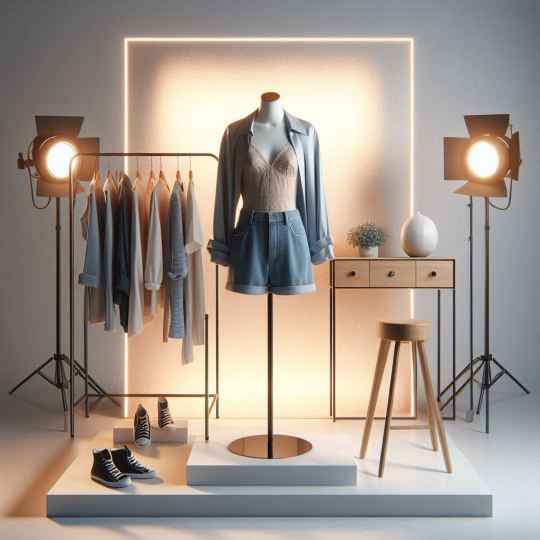
When it comes to showcasing apparel online, the way you present your product can significantly impact customer perception and sales. Two of the most popular methods in fashion and e-commerce photography are flat lay and ghost mannequin techniques. Each has its own style, strengths, and purpose.
In this article, we’ll explore the difference between flat lay and ghost mannequin photography, and help you decide which approach works best for your brand. We’ll also discuss how professional ghost mannequin services can elevate your product presentation and save you time.
What is Flat Lay Photography?
Flat lay photography is a simple yet effective method where clothing items are laid flat on a surface (often a plain white background) and photographed from above. This bird’s-eye view allows the viewer to see the full garment layout clearly.
Pros of Flat Lay:
Easy to set up: Requires minimal equipment and no model or mannequin.
Quick turnaround: Ideal for small businesses or product shots on a tight schedule.
Versatile presentation: Great for creating styled collections or mood boards.
Cons of Flat Lay:
Lacks depth and realism: Flat lay images don’t show how the garment fits on a human body.
Can look amateurish: Without professional styling and lighting, the result might appear unpolished.
Limited in product visualization: Customers may struggle to understand the fit, form, and structure of the item.
What is Ghost Mannequin Photography?
Also known as invisible mannequin photography, ghost mannequin is a more advanced technique used to give garments a 3D, life-like appearance without showing an actual mannequin or model in the final image. This is achieved by photographing the clothing on a mannequin and then editing it in post-production to remove the mannequin parts. The result? A floating, hollow look that highlights the shape, fit, and design of the apparel.
Pros of Ghost Mannequin:
Professional and clean look: Offers a consistent, high-quality aesthetic across all product images.
True-to-form fit: Shows how the garment naturally drapes on the body.
Boosts customer confidence: Helps buyers visualize the product better, reducing returns.
Cons of Ghost Mannequin:
Requires post-production: Needs skilled photo editing to remove the mannequin and assemble inner parts.
Slightly more complex setup: You’ll need a mannequin, lighting setup, and multiple shots (front, back, neck, etc.)
The Key Differences Between Flat Lay and Ghost Mannequin
Feature Flat Lay Ghost Mannequin Presentation Style 2D, bird’s-eye view 3D, realistic body-like shape Setup Simple setup Requires mannequin and styling Post-Processing Minimal editing Requires ghost mannequin editing Realism Lacks depth Shows true garment structure Use Case Mood boards, social media E-commerce product listings Customer Clarity Limited fit visualization High clarity of shape and fit
Why Brands Choose Ghost Mannequin Over Flat Lay
As e-commerce becomes more competitive, consumers are demanding high-quality visuals that accurately reflect what they’re buying. Flat lay might be great for Instagram posts or curated fashion content, but for online stores where conversions matter, ghost mannequin imagery wins.
With ghost mannequin photography, your product appears elegant, polished, and professionally presented. This style is particularly popular among fashion retailers, designers, and clothing brands that want to maintain a strong, trustworthy visual identity.
The Role of Professional Ghost Mannequin Services
If you’re considering using ghost mannequin images but don’t have in-house resources or time, outsourcing to professional ghost mannequin services is a smart choice. These services specialize in editing apparel photos to remove the mannequin while maintaining clean edges and accurate proportions.
Benefits of Hiring Ghost Mannequin Services:
Expert retouching: Seamless removal of mannequin and consistent detailing across images.
Faster turnaround: Save time on complex edits and focus on core business tasks.
Bulk editing: Great for fashion brands with hundreds or thousands of SKUs.
Brand consistency: Uniform, professional imagery that reflects your identity.
Professional ghost mannequin services ensure that your garments stand out with clean, high-definition, and on-brand visuals. Whether it's a t-shirt, dress, jacket, or lingerie, they know how to showcase each piece in the most appealing way.
When to Use Each Style
Choose Flat Lay If:
You’re creating casual or lifestyle content for social media.
Your brand has a minimalist aesthetic.
You’re working with a limited budget and equipment.
Choose Ghost Mannequin If:
You’re selling apparel on your website or marketplaces.
You want to reduce product returns by offering realistic visuals.
You need a polished and scalable solution for product photos.
Final Thoughts
Both flat lay and ghost mannequin photography have their place in the world of fashion marketing. The best choice depends on your brand goals, target audience, and how you want your products to be perceived.
That said, for most professional online stores, ghost mannequin services offer the ideal balance of realism, polish, and trust-building presentation. Investing in this type of editing not only enhances the visual appeal of your products but also increases the chances of converting browsers into buyers.
If you're ready to upgrade your apparel imagery and stand out from the crowd, consider working with a reliable ghost mannequin editing provider. Your products—and your customers—deserve it.
0 notes
Text
IIFD CHANDIGARH - College Review

When it comes to choosing the best Fashion Design College in India, especially in North India, IIFD – Indian Institute of Fashion & Design (@iifd), Chandigarh, is a name that’s gaining rapid recognition. From its innovative teaching methods to real-world fashion exposure, IIFD has emerged as a popular choice among young creatives.
But what is it really like to study at IIFD Chandigarh? Here's a detailed college review to help you decide if it’s the right fit for your fashion career.
Campus Environment & Infrastructure
IIFD’s campus in Chandigarh is modern, vibrant, and designed to inspire creativity. The classrooms are equipped with design labs, digital studios, sewing machines, mannequins, draping setups, and fabric resource libraries.
The campus encourages collaborative learning — whether you’re sketching with your peers, experimenting with textiles, or planning your first runway collection, IIFD provides a creative and comfortable space to grow.
Courses Offered
IIFD offers a wide range of fashion and design programs to suit every career path:
Fashion Design (Diploma, B.Des, M.Des)
Fashion Styling & Communication
Fashion Management
Interior Design
Textile Design
Makeup & Beauty Programs
The curriculum is industry-focused, meaning you don’t just study theory — you create real designs, work on live assignments, and build your portfolio while learning.
Faculty & Mentorship
One of the strongest points of IIFD is its faculty. The teachers are not just educators; they are industry professionals, designers, stylists, and mentors. The student-to-mentor ratio is kept low so that every learner receives individual attention, feedback, and grooming.
From day one, you feel like you’re not just studying at a college, but learning directly from the fashion world.
Industry Exposure & Events
This is where IIFD truly shines. Students get real-time exposure to the fashion industry through:
Participation in India Couture Week
Live projects at Chandigarh Times Fashion Week
International opportunities like the London Design Festival
Guest lectures by designers like Rina Dhaka, Neeta Lulla, and others
Backstage experiences, fashion shoots, and internships with top labels
These experiences are rare to find in many other colleges, and they give IIFD students a massive head start.
Placements & Career Support
IIFD has a dedicated placement cell that connects students with leading fashion brands, design studios, and retail companies. Students have received internships and jobs with:
H&M
Zara
Shoppers Stop
Export houses
Boutique labels
Fashion startups
Many IIFD graduates also start their own fashion labels or work as freelance designers and stylists.
Digital Presence & Portfolio Development
In today's fashion world, your online portfolio is just as important as your classroom performance. IIFD helps students build their digital identity through:
Behance and Instagram portfolio training
Personal brand styling
Content creation
Fashion blogging & YouTube sessions
This ensures students are visible and competitive in the digital fashion landscape.
Student Reviews & Satisfaction
Across online platforms like Google, JustDial, and CollegeDekho, IIFD scores high on student satisfaction. Students appreciate:
Practical training
Friendly and expert faculty
Fashion show experiences
International exposure
Campus environment
Whether you're in a diploma course or a degree program, students feel they are treated like designers from day one.
Final Verdict: Is IIFD Chandigarh Worth It?
If you’re serious about building a career in fashion, IIFD is one of the best fashion design colleges in India today. It blends creativity, confidence, and career-readiness in one complete experience.
From your first sketch to your first fashion week – IIFD guides you every step of the way.
#fashion designing#IIFD#IIFD Chandigarh#Education#careers#fashion design#fashion education#career#fashion design courses#interior designing#higher education#learning
1 note
·
View note
Text
Where Creativity Meets Career: Shaping Futures at Panacea Institute of Fashion Technology (PIFT)
In addition to teaching fashion, we at Panacea Institute of Fashion Technology (PIFT) also promote creativity. Being one of Mumbai's top Fashion Designing Institute In Mumbai, we are aware of the trends in the industry and incorporate them into our curriculum to produce designers who are prepared for the future.
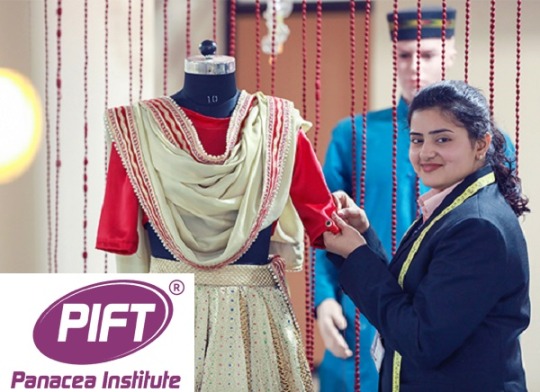
Why Choose Our Fashion Designing Institute in Mumbai?
● Curriculum That Is Dynamic
We consider changing global trends when curating our programs. We make sure you get up-to-date, innovative knowledge whether you're pursuing textile technology, clothing construction, or fashion merchandising.
● Creative Methods of Instruction
We combine contemporary digital tools with age-old methods. Our smart classrooms, industry projects, and design labs foster creativity and critical thinking.
● Mentoring in the Industry
We expose our students to leading designers, stylists, and production companies because of our central location in Mumbai, the fashion capital. Real-world opportunities like internships and live projects are accessible through our network.
● Practical Skill Development
We think that practice makes perfect. Our workshops provide extensive knowledge of clothing design, sketching, draping, and computer-aided design (CAD).
● Tailored Care
Every student receives individualized attention thanks to mentorship-driven instruction and small class sizes. This guarantees that their development is in line with their distinct goals and style.
Making Your Mark in Fashion
Enrolling in a course at Top Fashion Designing Institute In Mumbai is only one aspect of joining; another is adopting a lifestyle. Although the fashion industry is competitive, you can showcase your skills on both domestic and international catwalks if you follow the correct path.
What sets us apart?
● For prestigious fashion labels and houses, our alumni work dedicatedly.
● The media and stylists take notice of our fashion shows and exhibitions.
● We teach students how to lead and innovate in addition to designing.
We assist you in transforming your vision into a lucrative career, regardless of your preference for sustainable fashion, streetwear, or haute couture.
Allow your imagination to run wild with us. This is where your design story starts.
Credit:- https://panaceainstitute01.blogspot.com/2025/06/where-creativity-meets-career-shaping-futures-at-panacea-institute-of-fashion-technology.html
0 notes
Text
Elegant Comfort: Explore Sarees for Daily Wear and Handwoven Silk Grace
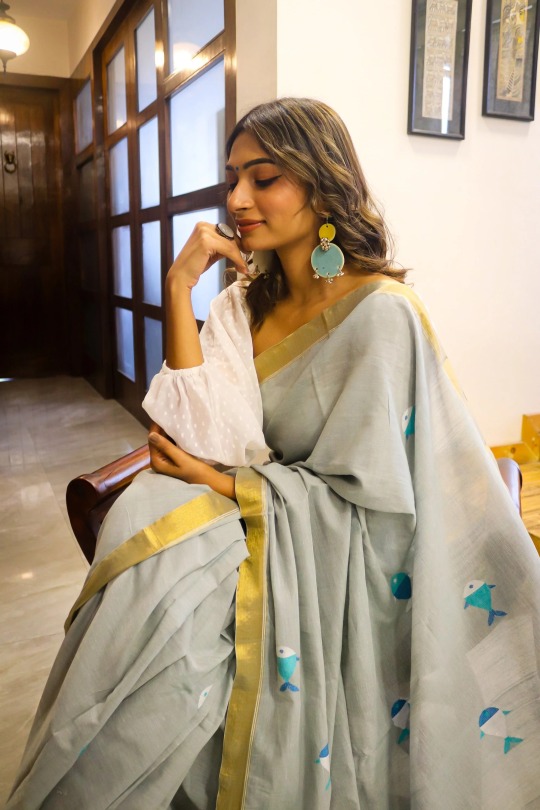
In today’s fast-paced world, women look for clothing that offers both comfort and elegance. That’s why sarees for daily wear are a timeless choice. Light, breathable, and easy to drape, daily wear sarees make everyday dressing simple without compromising on grace. From office hours to casual get-togethers, these sarees are perfect for any regular day.
What Makes Daily Wear Sarees Special?
Daily wear sarees are typically made from fabrics like cotton, linen, or light silk blends. They are skin-friendly, airy, and require less maintenance. Most importantly, they allow women to carry tradition in their everyday life without feeling restricted or overdressed. With simple prints and sober colors, they reflect subtle beauty that suits daily routines.
The Beauty of Handwoven Silk Online
With rising awareness of ethical fashion, many women now prefer silk handwoven sarees online. These sarees not only bring a luxurious feel but also support India’s rich weaving traditions. Made by skilled artisans using eco-conscious methods, every handwoven silk saree tells a story of heritage and craftsmanship. Available in a wide variety of designs and colors, they are ideal for special days or even as a graceful option for semi-formal wear.
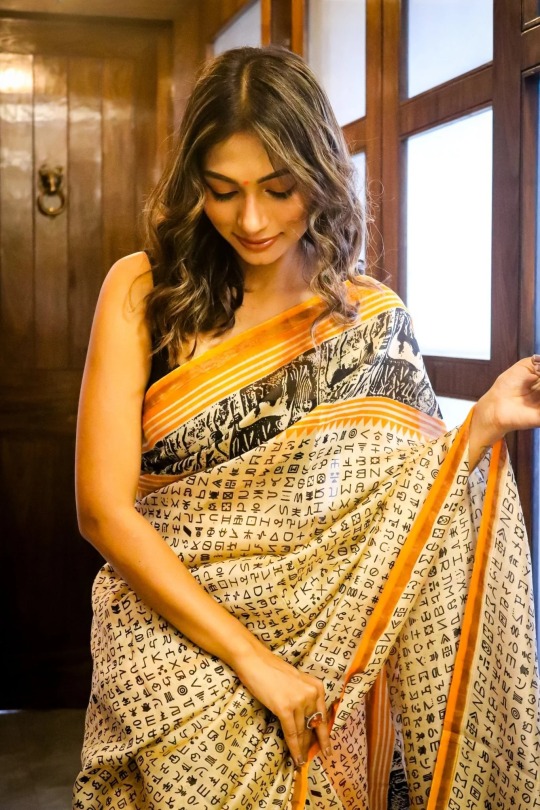
Shop Thoughtfully, Dress Gracefully
Brands like Zameeni bring authentic handwoven silk sarees directly from artisans to your doorstep. With a curated collection available online, it’s now easier than ever to add quality and culture to your wardrobe. Whether you're picking something for daily use or an elegant option for a family function, you’ll find a saree that matches your mood and values.
In conclusion, sarees for daily wear offer unmatched comfort while maintaining traditional appeal, and silk handwoven sarees online bring elegance to every occasion. Choose pieces that reflect not just style, but also the stories of the hands that made them.
Connect with Zameeni Online:
Instagram: https://www.instagram.com/zameeni_official/
Facebook: https://www.facebook.com/zameeniofficial
YouTube: https://www.youtube.com/@zameeniofficial
0 notes